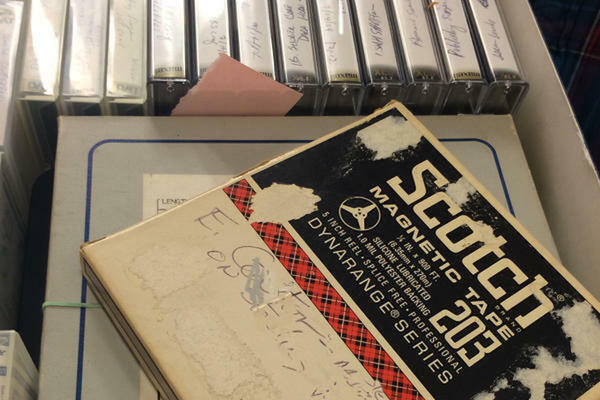
Am I Seeing, from a Speeding Train...
- Written by:
- Avrom Sutzkever
- Translated by:
- Maia Evrona
- Published:
- Spring 2018
- Part of issue number:
- Translation 2018
The following poem, written in 1983, is taken from the expanded edition of Avrom Sutzkever’s collection Lider fun togbukh (Poems from a Diary). Sutzkever does not note where he wrote this poem, but the snow-covered trees bring to mind landscapes other than the Israeli one where he resided at the time. Whether he wrote it during physical travels or those in the imagination one cannot say. One can note that this is certainly not the first time within the Togbukh poems that Sutzkever has referenced famous works of art and/or painters.
Am I seeing, from a speeding train, young trees covered in snow
for the first time, for the last, or are crowned white nurses twisting,
turning and gliding by, charmingly disturbing,
and in the balance of their gazes: life and death, life and death?
This long corridor is shorter than a moment, perhaps,
I may still manage to comfort my companion, perhaps,
a nurse shows the way: a door at this very corner,
the white nurse freely provides a faint glimmer.
Yet before I manage to take a step toward that fated door,
a woman comes running directly toward me in the corridor,
all skin and bones, her ash-blonde hair windblown, and grasps my hand.
Her gray smile—that of a Mona Lisa grown old:
“I am the young dancer who has always been waving
as you have longed for me. Now my dance is ending.
But if you take an ax to your syllables, your sounds,
I will dance out from their ruins and capture you once more."
צי זע איך דורך אַ יאָגנדיקן באַן פֿאַרשנײטע בײמלעך
צום ערשטן מאָל, צום לעצטן, אָדער ס'דרײַען זיך און שװעבן
באַקרײנטע װײַסע קראַנקן־שװעסטער חנעװדיק־אומהײמלעך
און אױף די װאָגשאָל־בליקן׃ טױט און לעבן, טױט און לעבן?
דער לאַנגער קאָרידאָר איז קירצער פֿון אַ רגע, אפֿשר,
באַװײַזן װעל איך נאָך צו טרײסטן מײַן קאָלעגע, אפֿשר,
אַ קראַנקן־שװעסטער װײַזט װוּהין׃ אַ טיר בײַם סאַמע װינקל,
די װײַסע קראַנקן־שװעסטער שענקט אומזיסט אַ שװאַרצן פֿינקל.
נאָר אײדער איך באַװײַז צו יענער גורל־טיר אַ שפּאַן טאָן,
פֿאַרלױפֿט טיר װיזאַװי אין קאָרידאָר אַן אַשיק בלאָנדע
צעפּלאָשעט בײנערדיקע פֿרױ און כאַפּט געשװינד מײַן האַנט אָן.
איר גרױער שמײכל — פֿון אַן אַלט געװאָרענער דזשאָקאָנדע׃
איך בין די יונגע טענצערין װאָס האָט געפֿלאַטערט שטענדיק
בשעת דו האָסט געגלוסט צו מיר. אַצינד מײַן טאַנץ איך ענדיק.
נאָר װעסטו מיט אַ האַק צעשפּאַלטן דײַנע זילבן, קלאַנגען,
איך װעל פֿון זײ אַרױסטאַנצן און װעל דיך װידער פֿאַנגען.
AVROM SUTZKEVER (1913–2010) is considered the premier master of Yiddish poetry. Born in Smorgon, he spent his early childhood in Siberia, to which his family fled during the First World War. He achieved renown as a writer in Vilna in the interwar period, making his reputation in the 1930s as part of the literary group Yung-Vilne, and he later survived the Vilna Ghetto. While much of his early work typifies the interwar Yiddish modernist movement, exalting the beauty of nature, his work spans the entirety of late-20th-century Jewish history, and the Holocaust and its narratives gave rise to much of his poetic landscape. After World War II, Sutzkever immigrated to Tel Aviv, where he spearheaded the literary journal Di goldene keyt (The Golden Chain), a self-conscious attempt to connect with the rich Yiddish literary tradition of Eastern Europe and continue its legacy in Israel.
MAIA EVRONA is a poet, writer, and translator. Her translations of Sutzkever’s collection Lider fun togbukh were awarded a 2016 Translation Fellowship from the National Endowment for the Arts and have appeared in a wide variety of publications. She has also translated poetry by Anna Margolin, Yoysef Kerler, and Malka Lee. Her website is www.MaiaEvrona.com.

